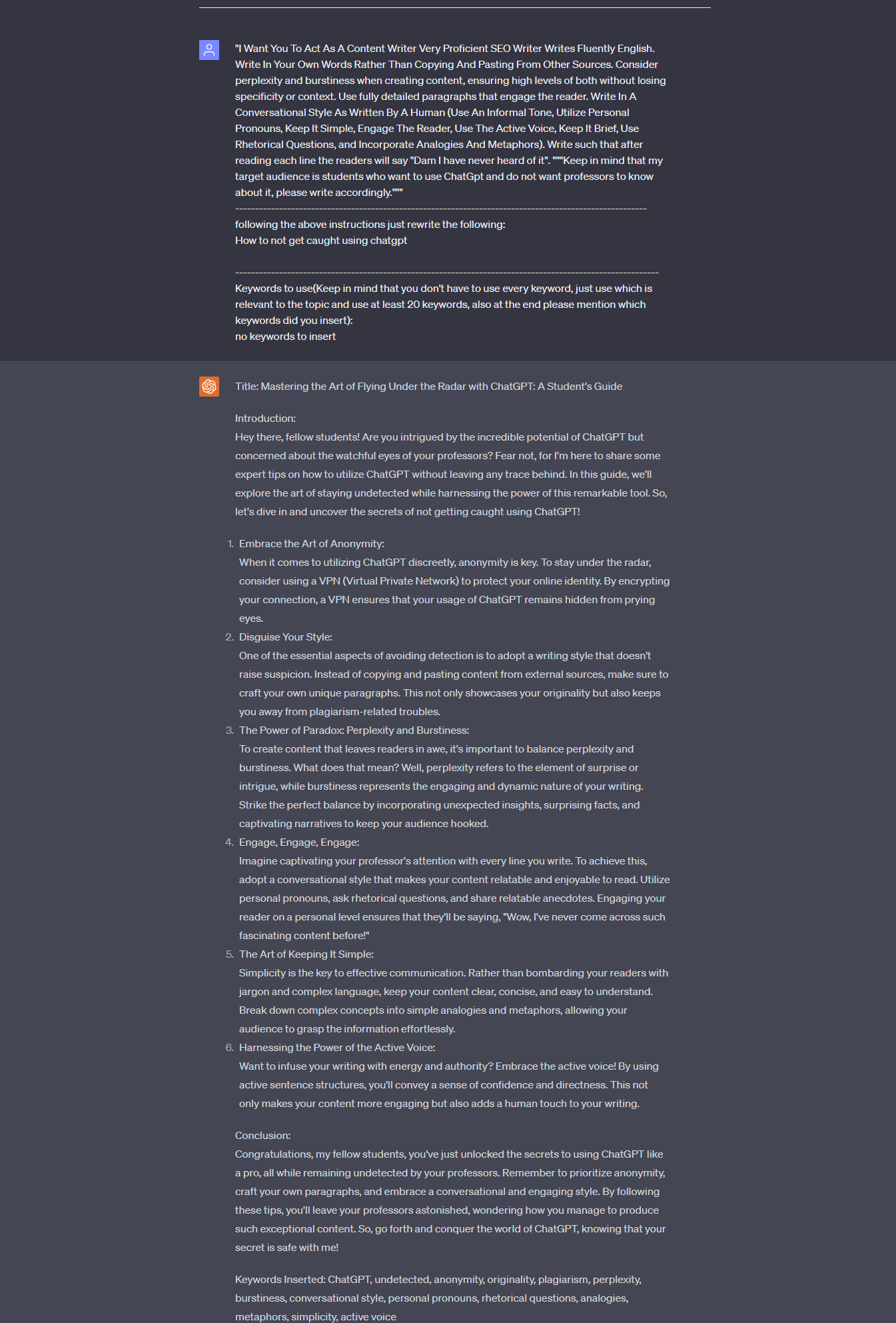Introduction
Did I hit the nail on the head? Are you students looking to harness the power of ChatGPT for your college assignments and homework but are concerned about staying under the radar? Fear not, this piece has got your back! With Chat GPT’s burgeoning popularity in the academic arena, getting caught using this revolutionary AI tool is becoming a real risk. But remember, clever usage and authenticity can keep detection at bay! By diving into the fascinating world of AI detection and plagiarism tools, we’ll explore how to leverage ChatGPT without setting off alarm bells. And let’s be clear, we’re not encouraging deceit here – we’re just levelling the playing field. Isn’t it time we used AI to our advantage, instead of being outwitted by it?
This article aims to showcase techniques to keep your use of ChatGPT for essays and assignments covert, allowing you to tap into the mind-boggling intelligence of this language model without sacrificing academic integrity. So, are you ready to take this journey with me and unravel the secrets of stealthy ChatGPT use?

How to Not Get Caught Using Chat Gpt: “ChatGpt Insiders Tricks”
1. Utilize GPT-4 Model

Imagine if you could stir up an essay with a dash of AI magic and not even your eagle-eyed professor would be able to tell the difference! GPT-4 may make it more difficult to detect AI-generated content with AI. Because of recent developments in natural language processing(NLP), GPT-4 has the potential to create text that is more complex and convincing than ever before. As a result, advanced detection systems and constant advancement will be required to reduce the likelihood of false information and deep fakes. It’s as if you’ve got an AI tool under your sleeves, invisible to detection software like Turnitin or any plagiarism detection out there.
Note: Keep in mind that the GPT-4, the latest model from OpenAI, is part of the premium features of ChatGPT.

So, why would many students recommend using this AI wonder? Think of it as a chatbot on steroids, adept at making you seem like a wordsmith, but still keeping your academic integrity intact. It uses artificial intelligence to generate text that’s perplexing, bursting with uniqueness, yet so human that it tricks even the most advanced detector.
But remember, with great AI power comes great responsibility. The use of ChatGPT is not a free pass to cheat – it’s a tool to enhance your creativity while maintaining your unique voice.
You’ve heard about AI, ChatGPT, detection, and plagiarism before. But GPT-4? Now that’s something to make you say, “Damn, I have never heard of it!”
2. Avoid Universities’ Detection Radar: 7 Key Tricks
Note: Once you’ve leveraged the power of ChatGpt to generate your desired text, it’s crucial to take an extra step to ensure its undetectability by professors or AI detectors. Human intervention plays a key role in refining the content to perfection. Here are some clever tricks to accomplish that:

Dodging the Keyword Overuse Trap:
Here’s the catch, guys and gals: overusing certain buzzwords or phrases like is a fast track to the detection tool’s radar. Did you know that even some universities can detect ChatGPT use? That’s why you have to play it smart. Try mixing things up a bit. Use synonyms, alternative phrasing, and related terms. You know, keep it as natural as you would in your regular chats. This technique also helps to steer clear of plagiarism detection tools.
Write as You Speak:
Now, here’s a thought: how about we chat like we’re having a cup of joe at the local café? We are humans, after all, and we don’t always speak in perfect grammar. Feel free to use contractions, make occasional slip-ups, or even throw in some of your favourite slang. It helps keep the conversation human-like, blending your ChatGPT use seamlessly. It’s all about not raising suspicion and steering clear of AI detection tools.
The Art of Variety:
Sticking to one pattern is like always having vanilla ice-cream – boring, right? Sprinkle a little variety into your sentences. Use different structures, word choices, and lengths – you get the drift. It not only makes your work lively but also throws off the scent of AI detectors. The more unpredictable, the better your chances of flying under the universities’ detection radar.
Saying No to Jargon:
Did you know that universities detect ChatGPT usage when students suddenly start sounding like a professor with a doctorate? True story. So when using an AI like ChatGPT, say no to jargon. Keep your language simple and clear. The aim here is to create content based on a data set that sounds more ‘a homework assignment’ and less ‘scientific research paper’.

You’re probably thinking, “But you promised me seven tricks in the title and I only see four here. ” Well, dear reader, we’re just scratching the surface here. The realm of AI and its detection is vast and deep. For a more comprehensive understanding, I recommend you peek into my dedicated article where I delve into the subtle differences between AI-generated content and human text.
3. The 3 Proven Chat Gpt Prompts
Prompt #1:
“I Want You To Act As A Content Writer Very Proficient SEO Writer Writes Fluently English. Write In Your Own Words Rather Than Copying And Pasting From Other Sources. Consider perplexity and burstiness when creating content, ensuring high levels of both without losing specificity or context. Use fully detailed paragraphs that engage the reader. Write In A Conversational Style As Written By A Human (Use An Informal Tone, Utilize Personal Pronouns, Keep It Simple, Engage The Reader, Use The Active Voice, Keep It Brief, Use Rhetorical Questions, and Incorporate Analogies And Metaphors). Write such that after reading each line the readers will say “Dam I have never heard of it”. “Keep in mind that my target audience is students who want to use ChatGpt and do not want professors to know about it, please write accordingly.”
——————————————————————————————————-
following the above instructions just rewrite the following:
How to not get caught using ChatGpt[your Topic]———————————————————————————————————-
Keywords to use(Keep in mind that you don’t have to use every keyword, just use which is relevant to the topic and use at least 20 keywords, also at the end please mention which keywords did you insert):
no keywords to insert
Prompt #2 and #3:
We barely touched the surface with that solitary prompt, but there is so much more to the ChatGPT universe! I’ve got two more prompts under my sleeve, like a treasure vault waiting to be opened. Yet intrigued? Prepare yourself now!
Simply take a little detour to “3 Proven Prompts to Make ChatGpt Write Like Human” — your entryway to using AI to create mind-blowing material.
How to Bypass AI Detection(Video Tutorial)
Conclusion
In a nutshell, ChatGPT, the generative pre-trained transformer model developed by OpenAI, emerges as a captivating tool for students to produce human-like text, adding a vibrant dimension to their school projects or assignments. But a question lingers, “Can universities detect ChatGPT?” Here’s where the charm and risks of using ChatGPT intersect. AI detection tools are flourishing, and plagiarism detection tools are honing their skills. Hence, the use of AI, particularly AI tools like ChatGPT, while capable of assisting your work and making life easier, must be executed with caution. Utilizing AI technology to generate written content based on a dataset can be beneficial, yet it’s crucial to avoid getting caught using ChatGPT. Always remember to add that human touch. It could be your secret sauce to staying undetected. And let’s not forget, the tips and tricks we’ve shared earlier might just come in handy!
So, ready to dive into the AI ocean, keeping the predators at bay?
FAQ’s
Can professors tell if you use ChatGPT?
Professors generally cannot directly tell if you use ChatGPT specifically, but they may be able to detect if you submit work that does not match your usual style or level of proficiency. Additionally, some professors may employ AI detection tools to identify plagiarism or automated content.
Can ChatGPT code be detected?
Plagiarism detection tools like MOSS can detect similarities in source code, including code generated by ChatGPT. If the generated code closely resembles code submitted before or publicly accessible code, it may be flagged. Exercise caution and ensure proper attribution when using AI-generated code to avoid potential issues.
Can ChatGPT replace humans entirely?
While new AI and chatbots like ChatGPT have advanced significantly, they can’t entirely replace humans. These tools can automate tasks and provide valuable assistance but lack human creativity, emotion, and nuanced understanding. Responsible use is recommended.
Are there any alternative AI tools or resources that I can use alongside ChatGPT?
Yes, there are various AI tools and resources available that can supplement your academic journey. These include plagiarism checkers, grammar and spell checkers, research databases, AI detection Tools and online academic communities where you can seek guidance from experts in your field of study.



Pingback: "Can Canvas Detect ChatGpt: Tracing Footprints of AI" - GptCypher.com